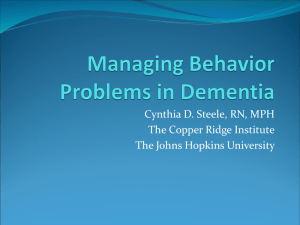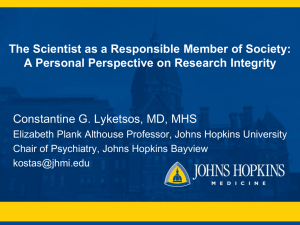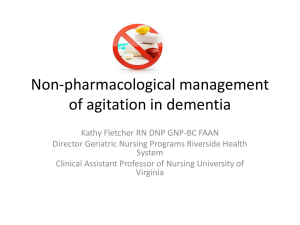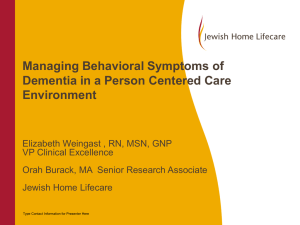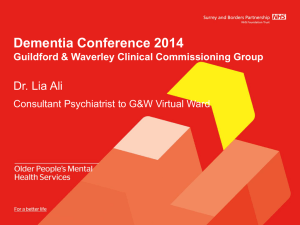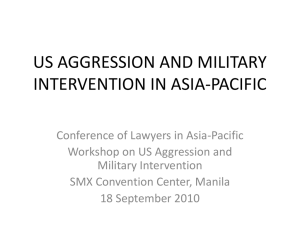- Integration of Psychiatry into Primary Health Care
advertisement
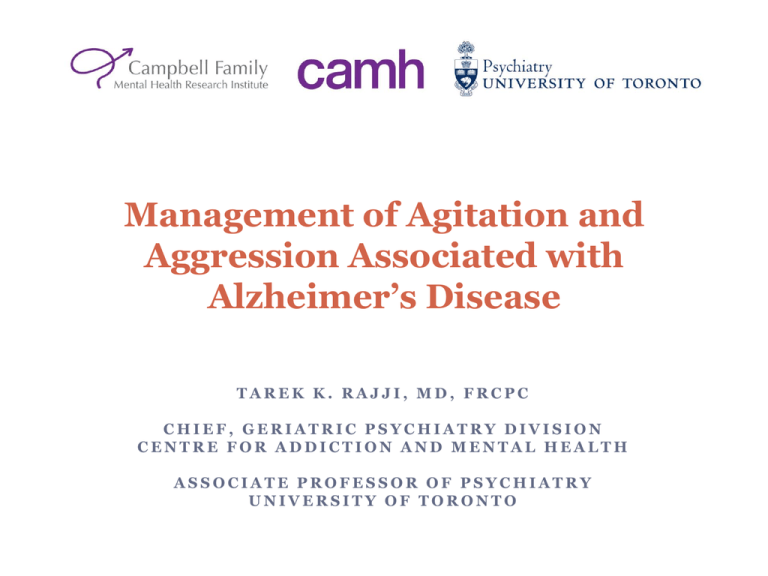
Management of Agitation and Aggression Associated with Alzheimer’s Disease TAREK K. RAJJI, MD, FRCPC CHIEF, GERIATRIC PSYCHIATRY DIVISION CENTRE FOR ADDICTION AND MENTAL HEALTH ASSOCIATE PROFESSOR OF PSYCHIATRY UNIVERSITY OF TORONTO Disclosures None Auguste Deter “One of the first disease symptoms of a 51-year-old woman was a strong feeling of jealousy towards her husband. Very soon she showed rapidly increasing memory impairments; … thought that people were out to kill her, then she would start to scream loudly.” Dr. A. Alzheimer, 1906. Auguste Deter “From time to time she was completely delirious, dragging her blankets and sheets to and fro, calling for her husband and daughter, and seeming to have auditory hallucinations. Often she would scream for hours and hours in a horrible voice.” Dr. A. Alzheimer, 1906 Behavioral and Psychological Symptoms of Dementia “AGGRESSION” Aggressive resistance Physical aggression Verbal aggression “APATHY” Withdrawn Lack of interest Amotivation “DEPRESSION” Sad Tearful Hopeless Low self-esteem Anxiety Guilt “MOTOR HYPERACTIVITY” Increased walking Walking aimlessly Moving objects Trailing “PSYCHOSIS” Hallucinations Delusions Misidentifications McShane, 2000 Behavioral and Psychological Symptoms of Dementia 90% of patients during the course of their illness (Tariot, 1999) 60-90% of patients with dementia suffer from BPSD (Lyketsos et al., 2002) Agitation & Aggression (75%) Wandering (60%) Depression (50%) Psychosis (30%) Screaming and violence (20%) Behavioral and Psychological Symptoms of Dementia Peak during moderate/moderately-severe stages (Reisberg et al., 1987) Agitation/aggression, apathy may continue to increase (Mega et al., 1996) Affective symptoms are more common early in the illness (Rubin et al., 1988) Jost & Grossberg, 1996 Agitation/Aggression Incidence: 50% over course of illness (Tariot & Blazina, 1994) Cummings, 2003 Aggression & Agitation in Dementia “Inappropriate verbal, vocal or motor activity not explained by apparent needs or confusion” (CohenMansfield, 1986) Aggression Physical Physical Verbal Agitation Physical Physical Verbal Agitation in Dementia: Subtypes Cohen-Mansfield,J. 1996. International Psychogeriatrics. 8(3):309. Treatment Algorithms: Evidence Algorithm use in clinical practice associated with: Improved quality of care Enhanced patient outcomes Reduced health care costs Adli. M et al. 2006. Biological Psychiatry. 59. 1029. Treatment Algorithms: Evidence Study year N Intervention TAU Results IMPACT (late-life depression) 2002 Int-906 Cont895 -Depression Algorithm -Case manager supervision of primary care -Primary care practitioner available mental health services Significant: -Decline in depressive sxs, - Decreased symptom severity -increased care satisfaction PROSPECT (late life depression) 2004 Int-320 Cont276 -Depression algorithm -Case manager supervision of primary care -primary care with education Significant reduction in: -remission time, -sx severity, -suicidal ideation TMAP (Texas Medication Algorithm Project) (depression) 2004 Int-175 Cont175 -Depression algorithm -psychoeducation -biweekly expert consultation - Outpatient care without algorithm use Significant : improvement in symptom severity and function at 1 year GAP (German Algorithm Project ) (depression) 2009 Int-74 Cont-74 -inpatient care with adherence to medication algorithm -inpatient mental health care Significant: decreased time to remission, fewer medication changes in remitters. Why do we need a pathway? Better Outcomes Better Knowledge New Approaches More Access More Data Pathway Assessment & Medications Discontinuation NonPharmacological Cognitive Enhancers (AChEI, Memantine) Pharmacological Zaraa, 2003 Physical Factors Delirium - Dipstix urine, check temperature and bloods e.g. FBC, U&E, LFT, TFT, ESR, CRP, Glucose, Vitamin B12, folate and ferritin levels Dehydration – check above blood levels; especially U&E. Commence on fluid balance chart Pain – complete appropriate pain assessment tool e.g. Abbey Scale Hunger – monitor and complete fluid and diet charts Constipation – monitor bowel habits Tiredness – chart sleep pattern Medication – side effects Medication withdrawals – e.g. benzodiazepines, opiates Sensory Impairment – sight &/or hearing deficit - refer to sensory impairment service for assessment and advice (where applicable) Hypoxia – cyanosis, laboured breathing NHS Forth Valley Psychological Factors Depression – observe for any mood or behavioural changes. Complete appropriate assessment tool Hallucinations – more commonly seeing&/or hearing things. NB exclude delirium Delusions – more commonly paranoia &/or suspiciousness. NB exclude delirium Sundowning - increased agitation and activity occurring in the late afternoon/early evening NHS Forth Valley Environmental Factors Noise levels – over stimulation/elevated noise levels can be antagonistic Lack of social stimulation Inappropriate music – ensure age related and appropriate to the client group Environment/layout Is it conducive to the specific client group? Could it potentially increase confusion and disorientation in people suffering from cognitive impairment? NHS Forth Valley Hospitalist DIAGNOSTIC WORK-UP: PHYSICAL EXAM INVESTIGATION Y E S N O Y E S N O Y ES N O Basic investigation done to rule out other medical causes of cognitive impairment or agitation Name: Sign: Date: (dd/mm/yyyy) Guidelines: vital signs, height, weight, waist circumference, CBC with differential, renal function, liver panel, metabolic/endocrine function, B12, urine analysis, urine C&S, lipid profile, fasting glucose +/- HbA1C, micro albuminuria, extended electrolytes, Delirium screening tool (optional) Examples: Confusion Assessment Method, Delirium Symptom Review, Delirium Rating Scale Addition investigations performed as indicated (optional) List additional investigations: ____________________________________________________________________________________ ______ Attending Physician DIAGNOSTIC WORK-UP: HISTORY Agitation or aggression is present Name: Sign: Date: (dd/mm/yyyy) Clinically suspected to be secondary to Alzheimer’s or mixed Alzheimer’s + vascular dementia History consistent with Alzheimer’s or mixed Alzheimer’s vascular dementia Attending Physician DECISION TO MOVE FORWARD Delirium or other causative medication/medical condition identified? Presentation more consistent with non-Alzheimer’s Dementia? Name: Sign: Is the Agitation and Aggression: If “Yes” exit pathway Severe? Causing distress to the patient? Or OTHERS? Preventing or interfering with providing necessary care to the patient? Date: (dd/mm/yyyy) Posing a risk to the patient or to others? If “Yes” to ANY questions, proceed with pathway, otherwise exit pathway Clinical Global Impression Scale (CGI) Initial Score: _________________________ Attending Physician Abnormal Involuntary Movement Scale (AIMS) Name Sign: Date: Initial Score: _________________________ Simpson-Angus Scale (SAS) Initial Score: _________________________ (dd/mm/yyyy) Barnes Akathisia Scale (BAS) Sign: Comments: ________________________________ ________________ Initial Score: _________________________ ________________________________ ________________ Comments: ___________________________________ _____________ Date: Montreal Cognitive Assessment (MOCA) Initial Score: _________________________ (dd/mm/yyyy) Alzheimer’s disease assessment scale – cognitive subscale (ADAS-cog) Initial Score: _________________________ YE S NO ___________________________________ _____________ Comments: ___________________________________ _____________ Cohen-Mansfield Agitation Inventory (CMAI) Initial Score: _________________________ NO ___________________________________ _____________ Comments : ___________________________________ _____________ ___________________________________ _____________ Neuropsychiatric Inventory (NPI) YE S ________________________________ ________________ Comments : ___________________________________ _____________ Initial Score: _________________________ Research Fellow Name Comments : ________________________________ ________________ ___________________________________ _____________ Comments : ___________________________________ _____________ ___________________________________ _____________ Comments : ___________________________________ _____________ ___________________________________ _____________ Hospitalist CARDIAC AND METABOLIC ASSESSMENT Name CBC, ECG, Creatinine/BUN, Blood Sugar, Lipid Profile Sign: Comments: ___________________________________________________________________________________ _________ Date: (dd/mm/yyyy) Assigned Nurse YES NO YES NO ___________________________________________________________________________________ _________ PAIN ASSESSMENT AND MANAGEMENT Name: Pain Assessment and Management Conducted Sign: Date: (dd/mm/yyyy) For example: Brief Pain Inventory (BPI) for verbal patients Checklist of Non-Verbal Pain Indicators (CNPI) for non-verbal patients Occupational Therapist FUNCTIONAL ASSESSMENT Name: Functional Assessment Staging (FAST) Sign: Date: (dd/mm/yyyy) Comments: ____________________________________________________________________________________ ________ ____________________________________________________________________________________ ________ YES NO Pathway Assessment & Medications Discontinuation NonPharmacological Cognitive Enhancers (AChEI, Memantine) Pharmacological Non-Pharmacological Interventions Consent Caregiver education and support Enhance communication with the patient Ensure safe environment Increase or decrease stimulation in the environment Non-Pharmacological Interventions For all BPSD: 31 studies that used RCT-design (1-52 weeks): Reminiscence mild to moderate depression (7/8) Pleasant activities with or without social interactions agitation (4/4), depression (2/2) Personalized music agitation (4/7) Exercise depression (2/5) Non-Pharmacological Interventions Allied Health Professional Please check discipline: Occupational Therapist NON-PHARMACOLOGICAL INTERVENTIONS IDENTIFIED INITIALLY AS MOST APPROPRIATE* Social Contact Pet therapy One-to-one visit Recreation Therapist Other:_________ ______ Sensory Enhancement/ Relaxation Hand massage Individualized Music Social Worker Purposeful Activity Exercise group Helping tasks / Volunteer role Inclusion in group programs of identified interest Individualized art Primary Nurse Physical Activity Access to outdoors Indoor/outdoor walks Individual exercise program Sensory modulation Name: Other:_________ ______ Sign: Date: Other:__________ Other:__________ _____ _____ Multisensory Snoezelen System Paro Therapeutic Robot Pharmacological Interventions Risperidone Aripiprazole Quetiepine Citalopram Carbamazepine Gabapentin For partial responders: 1. Extend the trial 2. Increase the dose 3. Augment with another agent that showed also partial response Prazosin ECT PRNs: 1. Trazodone 2. Lorazepam Drugs commonly used for agitation Antipsychotics Antidepressants SSRIs, trazodone Cognitive enhancers Cholinesterase inhibitors, memantine Mood stabilizers and Anticonvulsants carbamazepine valproic acid gabapentin oxcarbazapine topiramate lamotrigine lithium Antipsychotics Treatment Trials conducted Evidence Typicals 11 randomized, placebocontrolled trials; duration bw 4-16 wks Modest advantage over placebo Atypicals 18 placebo-controlled trials (6-12 wks) 3 trials 6-12 months) Best option for shortterm (6-12 wks) 1. Schneider L. Am J Geriatr Psych 2006:14(3) 191-212. 2. Ceitz et al. Cochrane Review, 2011. 3. Ballard & Corbett. 2013:25(3)252-259. Antipsychotics Mainstay of psychopharmacological treatment Up to 40% of all dementia patients prescribed antipsychotics1 Atypicals vs. typicals: perceived safety advantage In patients with dementia, atypicals increase: risk of death (OR=1.5 - 1.7) cerebrovascular adverse events (OR=2.7) rate of cognitive decline 1. Schneider L. Am J Geriatr Psych 2006:14(3) 191-212. 2. Ballard & Corbet. Current Opin Pysych. 2013:226(3)252-259. 3. Hermann & Lanctôt. Drug Safety. 2006:29(10) 833-843. Atypical Antipsychotics Antipsychotic # trials Bottom Line Risperidone 5 RCTs • Provides best evidence for treating aggression • Modest but significant improvement vs. placebo • Biggest effect size: 2 mg daily Olanzapine 5 RCTs (fixed dose 1-15 mg daily, 6-10 weeks of treatment) Schneider L. Am J Geriatr Psych 2006:14(3) 191-212. Ballard et al. Cochrane Review. 2012. • Conflicting evidence • More adverse events of hostility, abnormal gait, somnolence • Not associated with overall efficacy Atypical Antipsychotics Antipsychotic # trials Bottom Line Aripiprazole 2 RCTs • Benefits similar to risperidone • Caveat: studied in context of psychosis Quetiapine 3 RCTs • significantly > cognitive decline • ineffective in treating agitation Schneider L. Am J Geriatr Psych 2006:14(3) 191-212. Ballard et al. Cochrane Review. 2012 Antidepressants SSRI’s # trials Main findings Meta-analysis of 9 trials, n=692; five studies compared SSRIs to placebo, only two studies included in metaanalysis1. Some benefit shown for sertraline & citalopram for overall BPSD vs placebo; no statistically significant difference vs. antipsychotics. Limited trials addressing aggression or agitation Citalopram vs. placebo: ↓ agitation and aggression May have role in treating aggression and agitation Citalopram vs. risperidone: improved effect on agitation, better tolerated Better tolerated than antipsychotics Indicated if depression present 1. Ballard & Corbegtt. Current Opin Psychiatry. 2013 26(3) 252-259. 2. Pollock, BG, Mulsant, BH, Rosen J et al. Am J Pscychiatry 2002; 159:450-465. 3. Pollock, Mulsant, Rosen et al. Am J Geriatr Psychiatry Antidepressants Trazodone studies # placebo-controlled RCTs Bottom line Martinon et al. 2 placebo-controlled RCT’s (n=104; dosage 50300 mg, up to six weeks) No significant benefit vs. placebo Henry et. al. 3 original trials • 1 trial vs. placebo) • 2 trials vs. haloperidol • trazodone > haldol • trazodone = haldol=placebo 1. Martinon et al., Cochrane Review, 2008 2. Henry et al. Am J Alz Dis & Other Dementias 2011:26(3) 169-183. Cognitive Enhancers Cognitive enhancer #P-C RCTs included Outcome on agitation donepezil 9 2 positive 1 trial positive for continuing vs. placebo after initial open label treatment phase galantamine 3 1 positive rivastigmine 2 0 positive Rodda et al. Int. Pyschoger 2009:21:5;813-24 Anticonvulsants & mood stabilizers Drug Overall findings for agitation & aggression Bottom Line Carbamazapine - Few clinical trials (1 meta-analysis, 3 clinical trials) - Conflicting evidence Promising for global BPSD, esp. agitation & aggression (dose 300-600 mg over 6-8 wks) - ↑ risk drug-drug interactions, poorly tolerated in long-term use Not recommended for routine treatment of agitation - Meta-analysis: unacceptable rate of adverse effects (esp. sedation) > 15mg/kg/d - 3 RCTs: no improvement in aggression; 1 RCT: worsened hostility; Higher quality studies including RCTs and meta-analyses do not support use for agitation; may worsen aggression Valproate Yi-Chun & Ouyang. Kaoh J of Med Sci (2012): 28, 185-193. Drug Overall findings for agitation & aggression Bottom line Gabapentin No meta-analysis or RCTs Data limited (11 case reports, 3 case series, 1 retrospective chart review) well tolerated, some effectiveness for overall BPSD, (mean dose 900 mg daily) - dearth of data Oxcarbazepine One RCT on agitation & aggression Negative results Topiramate Lack of RCTs Adverse effect on cognition Use not supported in BPSD Lamotrigine Case series, case reports, no RCTs using objective measures May be effective Adverse effects: rash, somnolence, tremor Lithium Case series, most > 20 y o, lack of valid instruments Conflicting results Yi-Chun & Ouyang. Kaoh J of Med Sci (2012): 28, 185-193. Anticonvulsants & mood stabilizers Summary: CBZ most promising mood stabilizer for patients with aggression, hostility and (possibly) agitation Also effective for global BPSD Effective dose range: 300-600 mg daily over 6-8 weeks Electro-Convulsive Therapy (ECT) Case series, 4 patients, failed psychotropics 2 to 4 ECT sessions meaningful reduction in symptoms for 3 to 12 months (Grant et al. 2001) Case series, 3 patients with manic-like symptoms, failed psychotropics 1-2 weeks of ECT followed improvement in mania and agitation (McDonald et al. 2001) 92 year-old female, vascular dementia, failed haloperidol 2 ECT sessions BPSD resolves for 3 months (Katagai et al. 2007) Electro-Convulsive Therapy (ECT) 16 hospitalized patients (mean age = 66.6, SD = 8.3) with mild to severe dementia. 12 patients bilateral ECT 3 patients right unilateral ECT bilateral ECT 1 patient only right unilateral ECT On average, 9 treatments (range: 2 to 15) All patients improving except for one Ujkaj et al. 2012 Pathway of Care Risperidone Assessment & Medications Discontinuation Aripiprazole Citalopram NonPharmacological Carbamazepine Cognitive Enhancers (AChEI, Memantine) Pharmacological Gabapentin Prazosin ECT Quetiepine • Dr. Amer Burhan • Dr. Simon Davies • Dr. Donna Kim • Dr. Benoit Mulsant • Dr. Bruce Pollock • Dr. Vincent Woo • Ms. Rong Ting • Dr. Sawsan Kalache • Ms. Saima Aiwan • Mr. Christopher Uranis

